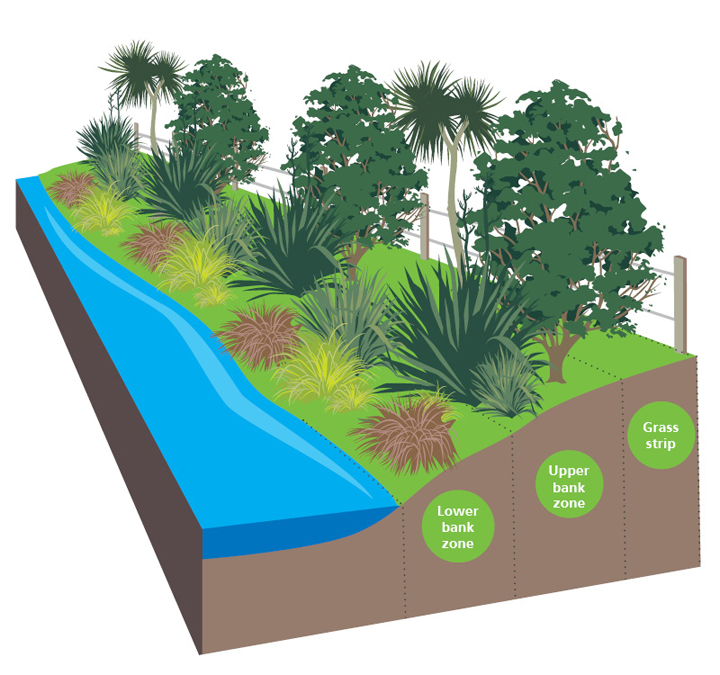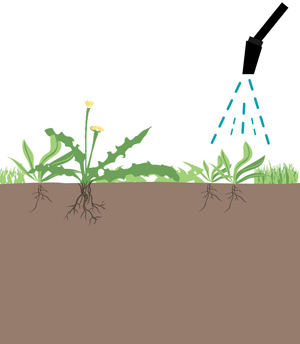Riparian Planting
4 min read
Riparian planting can improve your farm's environmental performance. Whether it’s a river, drain, stream, wetland, lake or pond, planting at the water’s edge has many benefits.
The plants in these areas act as a filter and stabiliser, decreasing erosion and run-off to protect water quality. They can also boost the health of plants, fish and animals in and around the water.
Riparian plants act as filters to trap contaminants such as chemicals, nutrients, sediment, and bacteria before they enter the waterway. This helps improve water quality and the suitability and habitat for creatures living in the ecosystem.
Trapping as many nutrients as possible, such as nitrogen and phosphorus, before they enter the waterway is critical to ensuring the waterway’s biodiversity is supported. It also reduces the risk of algal blooms and nuisance aquatic plants. Gaining an understanding of your farm's contaminant hotspots is a great step before deciding where to put riparian plants.
Visit DairyNZ's contaminants page to find out more.
While some sediment movement is a natural part of the freshwater ecosystem, too much can smother the organisms living in the waterway.
Riparian planting helps reduce erosion, keeping soil in the paddock and maintaining stream bank structures. The root systems of riparian plants stabilise the stream bank and reduce the amount of erosion and sediment reaching the stream.
For more information on erosion on farms and how to reduce it, visit Waterway erosion.
Once established, riparian plants shade the water and lower its temperature, reducing weed and algae growth and providing stable temperatures for aquatic life.
Without shade, the water temperature can fluctuate, and New Zealand native fish generally can't tolerate temperatures above 25°C.
Warmer water temperatures can also lead to increased aquatic plant and algae growth. This can then clog the water flow, decreasing oxygen levels needed by native fish and invertebrate communities.
The riparian zone provides a great variety of habitats for different native species. The roots can be hiding and spawning spots essential for native species. Plants also provide overhanging habitat and a source of food for animals living in the water.
In ecosystems, all species have their role to play. The larger the range of species, the more stable the entire system is and the better it can deal with stress and disruption, such as fluctuations in water temperatures and pest species.
There are three distinct planting zones in riparian margins, each serving a unique purpose.
Planting vegetation on the upper and lower banks enhances waterway conditions for aquatic animals and boosts terrestrial biodiversity. Additionally, allowing rank grass to flourish near laneways, bridges, culverts, and swales helps filter out sediment and phosphorus, particularly during periods of excess rainfall, preserving the health of waterways.

Grass strip
Grass strips should be left between riparian planting and fences to prevent plants from tripping electric wires. Also, leave rank grass in areas where swales enter waterways.
Upper bank zone
The upper bank zone is on higher ground but may remain partially flooded every couple of years. Use flaxes, grasses, shrubs, or trees that provide shade and shelter to the waterway channel.
Lower bank zone
The lower bank zone is prone to flooding, so plants need to be tolerant of waterlogging. Use well-rooted plants such as sedges and rushes, which can survive many days under water. Plant close to the waterway edge to provide important overhanging habitat for animals living in the waterways.
When deciding what to plant and how wide the riparian margin should be, it's crucial to consider the orientation of the waterway. This consideration is vital because riparian planting offers a significant benefit: providing shade to the river.
This shade serves two crucial purposes. It helps reduce water temperature and prevents excessive plant growth. For these benefits to be fully achieved, rivers require a minimum of 70 percent shade coverage.
| Both banks planted: | ||
| North-south flowing stream | East-west flowing stream | Meandering stream |
| Plant height needs to be at least 80 percent of the stream width | Plant height needs to be at least 150% stream width. | Plant height needs to be at least 75% stream width. |
| One bank planted: | ||
| North-South flowing stream | East-west flowing stream | To create more shade |
| One bank planted North-South does not achieve 70% shade for aquatic weed control, but is likely to slow aquatic weed growth, improve temperature and water quality | Plant height= 3x stream width and overhanging canopy.Taller vegetation on the North bank. | Have taller plants, plants overhanging the channel, and/or meandering channels. |
Once you understand your waterway and what you are trying to achieve, the next step is to create a plan. Creating a planting plan and having a maintenance strategy are essential for a successful riparian planting programme.
Use the DairyNZ Waterway technote, the NIWA riparian guidelines and the Plant your Patch website for more detailed information on site selection, planning, and plant selection.
1. Remove grass and weeds
Four to six weeks before planting, spray 1m diameter circles with a glyphosate-based herbicide at the location each plant will be planted.

2. Dig a hole that is big enough to accommodate plant roots without them being curled up or bent in the hole.
On drier soils, ensure the base of the stem is 1-2cm below the soil surface.
Mulch around plants will help keep soils damp, reduce weeds, and provide nutrients.
Good mulches include straw, staked-down cardboard, or wool.

3. Put a stake beside plants (unattached) so they can be easily seen when weeding and identified if they have died and need replacing.

Keeping on top of weeds and pests is crucial in the first five years for establishing a healthy riparian area.
The most effective maintenance option combines the protective and active maintenance methods below.
Surround each plant with at least a 30-40cm diameter of biodegradable weed mat, mulch or old woollen carpet to suppress weed growth.
Avoid using plain wood chip around the plant as it will strip all the nitrogen out of the soil causing the plant to yellow off and die.

Stake each plant for an accessible location and brush cut, hand weed or carefully spray with a glyphosate-based herbicide twice a year.
If spraying, follow product guidelines - desired plants are usually sensitive to herbicides, so caution must be taken to protect against spray drift.
Video: Three plant releasing techniques to make your riparian planting a success
Individual plantings are a great first step for protecting and enhancing a waterway. However, to really move the dial, getting together with your neighbours and taking a whole catchment view is the most impactful way you can improve your waterways. DairyNZ has a great range of resources for starting and maintaining catchment groups. Visit DairyNZ catchment group support for more information and links to other great resources.
Riparian planting could be an action to consider as part of your Freshwater Farm Plan. For more information visit the Freshwater Farm Plans page.
Getting Riparian Planting Right guides were developed in consultation with farmers, dairy companies and regional councils, to support farmers with meeting their riparian planting requirements in The Sustainable Dairying: Water Accord.